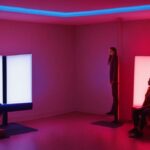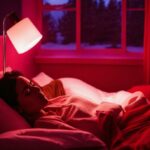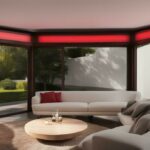Light therapy units are medical devices that use a specific type of light to treat various conditions, including seasonal affective disorder (SAD), sleep disorders, and skin conditions such as psoriasis. These devices emit bright light that mimics natural sunlight and can be used at home or in a clinical setting to help regulate the body’s circadian rhythm and improve overall well-being. In this article, we will delve deeper into the benefits and potential uses of a light therapy unit.
Contents
Understanding Light Therapy Units
Light therapy, also known as phototherapy or bright light therapy, is a treatment that involves exposure to specific wavelengths of light. This type of therapy is often used to treat seasonal affective disorder (SAD), a form of depression that typically occurs during the winter months. However, light therapy can be used to treat a wide range of other conditions, including sleep disorders, skin conditions, and chronic pain.
a light therapy unit is a device that emits specific wavelengths of light that are designed to have therapeutic effects on the body. These devices come in a variety of shapes and sizes, from small handheld devices to large floor lamps. Light therapy units typically emit bright white light, although some devices emit blue or green light.
How Does Light Therapy Work?
Light therapy works by stimulating the body’s natural response to light. Exposure to bright light can help regulate the body’s circadian rhythms, which can improve sleep quality and reduce symptoms of depression. Light therapy can also help reduce inflammation in the body and promote the production of serotonin, a neurotransmitter that is associated with feelings of happiness and well-being.
What Are the Benefits of Light Therapy?
Light therapy has been shown to have a number of benefits for both physical and mental health. Some of the most significant benefits of light therapy include:
- Improved sleep quality
- Reduced symptoms of depression
- Reduced anxiety
- Reduced fatigue
- Reduced pain and inflammation
- Improved skin health
- Increased energy levels
Choosing a Light Therapy Unit
If you’re interested in trying light therapy, there are a number of factors to consider when choosing a light therapy unit. Here are some of the most important factors to keep in mind:
Light therapy units can improve both physical and mental health by regulating circadian rhythms, reducing symptoms of depression and anxiety, improving sleep quality, reducing pain and inflammation, increasing energy levels, and promoting skin health. When choosing a light therapy unit, consider the light intensity, color, size and portability, and price. To use a light therapy unit, position it at a distance of 12-18 inches from your face or affected area for 20-30 minutes per day, preferably in the morning, while keeping your eyes open but not staring directly at the light. Side effects may include eye strain, headache, nausea, irritability, and insomnia. Consult a healthcare professional if these occur.
Light Intensity
The intensity of the light emitted by a light therapy unit is one of the most important factors to consider. Light intensity is typically measured in lux, with higher lux values indicating brighter light. For most people, a light therapy unit with an intensity of 10,000 lux is sufficient to achieve the desired therapeutic effects.
Light Color
As mentioned earlier, most light therapy units emit bright white light. However, some devices emit blue or green light, which may be more effective for certain conditions. Blue light has been shown to be particularly effective for treating sleep disorders, while green light has been shown to be effective for treating skin conditions.
Size and Portability
Light therapy units come in a variety of sizes, from small handheld devices to large floor lamps. Consider where you’ll be using the device and whether you need a portable option that you can take with you on the go.
Price
Light therapy units can range in price from less than $50 to several hundred dollars. Consider your budget and how often you plan to use the device when choosing a light therapy unit.
How to Use a Light Therapy Unit
Using a light therapy unit is relatively simple. Here are some tips for getting the most out of your device:
- Position the device so that the light is directed at your face or the affected area of your body.
- Use the device for 20-30 minutes per day, preferably in the morning.
- Sit or stand at a distance of about 12-18 inches from the device.
- Keep your eyes open while using the device, but don’t stare directly at the light.
- Be consistent with your use of the device. Light therapy is most effective when used on a regular basis.
Light therapy units can be used to treat a variety of conditions, including seasonal affective disorder, sleep disorders, skin conditions, chronic pain, and more. These devices emit specific wavelengths of light that stimulate the body’s natural response to light, regulating circadian rhythms, reducing inflammation, and promoting the production of serotonin. When choosing a light therapy unit, consider factors such as light intensity, color, size, portability, and price. To use a light therapy unit effectively, position it properly, use it regularly for 20-30 minutes per day, and be aware of potential side effects such as eye strain and irritability.
Potential Side Effects of Light Therapy
While light therapy is generally safe and well-tolerated, there are some potential side effects to be aware of. These can include:
- Eye strain
- Headache
- Nausea
- Irritability
- Insomnia
If you experience any of these side effects, reduce the duration or intensity of your light therapy sessions, or consult with a healthcare professional.
FAQs for Light Therapy Unit
What is a light therapy unit?
a light therapy unit is a medical device that emits artificial light, specifically designed to mimic natural sunlight. The device is typically used to treat seasonal affective disorder (SAD) and other types of depression.
How does a light therapy unit work?
Light therapy works by exposing individuals to an intense light source, which is designed to mimic natural sunlight. The device emits a specific wavelength of light that is intended to help regulate the body’s natural circadian rhythms. This is believed to help regulate mood, and alleviate symptoms of depression.
What are the benefits of using a light therapy unit?
In addition to treating SAD and depression, light therapy has been shown to be effective in treating a variety of other conditions. For example, it can be used to alleviate symptoms of jet lag, postpartum depression, and sleep disorders. Light therapy has also been shown to be effective in treating skin conditions such as psoriasis and eczema.
Who can benefit from using a light therapy unit?
Light therapy is typically recommended for individuals who experience seasonal affective disorder (SAD) or other forms of depression. However, it can also be beneficial for individuals who have difficulty regulating their sleep cycles or who experience symptoms of jet lag or other sleep disorders. Additionally, light therapy may be useful in treating certain skin conditions, such as psoriasis and eczema.
What are the side-effects of using a light therapy unit?
While light therapy is generally considered to be a safe and effective treatment, there are some potential side-effects that can occur. These include headaches, eye strain, and nausea. Additionally, some individuals may experience a worsening of their depression symptoms, although this is relatively rare.
How long should I use a light therapy unit?
The length of time that an individual should use a light therapy unit will vary depending on their specific needs and condition. In general, it is recommended that individuals use the device for 30 minutes to 2 hours per day, depending on the intensity of the light and the severity of their symptoms. It is typically recommended that individuals use the device for at least two to three weeks to begin to see benefits.
Can light therapy replace medication for depression?
While light therapy has been shown to be effective in treating certain types of depression, it is not intended to replace traditional medications. For individuals with moderate to severe depression, a combination of medication and light therapy may be the most effective course of treatment. It is important to speak with a qualified healthcare provider to determine the appropriate course of treatment for your specific needs.


.jpg)





